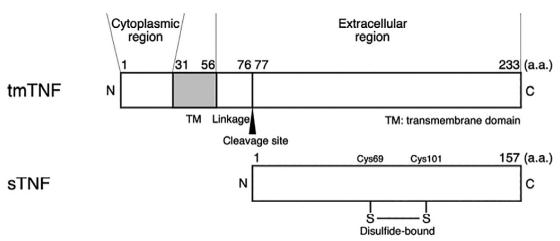TUMOR NECROSIS FACTOR
- Molecular Weight: 0
- MDL number: MFCD00080185
- Update Date: 2023-03-21 13:45:01
What is TUMOR NECROSIS FACTOR?
Description
The importance of TNF is highlighted by its discovery in diseases and multiple key biological processes including immune homeostasis, cell proliferation, differentiation, apoptosis, lipid metabolism, and coagulation. TNF was originally found in mouse serum after the intravenous injection of bacterial endotoxin into mice primed with a viable Mycobacterium bovis Bacillus Calmette-Guerin (BCG) strain; it was shown to cause the necrosis of tumors. Human TNF cDNA and its mRNA were identified in 4β-phorbol 12β-myristate 13α-acetate (PMA)-stimulated HL-60, a monocyte-like cell line derived from a promyelocytic leukemia. The biosynthesis of TNF was clarified by the identification of the cell surface precursor transmembrane form and its processing enzyme, TNF-α-converting enzyme (TACE).
Physical properties
Mr. 26,000 (tmTNF), 17,000 (sTNF). pI 5.8 (human sTNF). TNF is soluble in water. TNF is stable in plasma and serum for 8 h at room temperature and for 24 h at 4°C, -20°C, or -70°C.
General Description
The TNFs (Etanercept, Enbrel) are members of a family ofcytokines that are produced primarily in the innate immunesystem by activated mononuclear phagocytes. Etanercept is a dimeric fusion protein consisting of the extracellularligand-binding portion of the human 75-kDa (p75)TNF receptor (TNFR) linked to the Fc portion of human isotypeIgG1. The Fc component of etanercept contains the CH2domain, the CH3 domain, and the hinge region, but not theCH1 domain of IgG1. These regions are responsible for thebiological effects of immunoglobulins. Each etanerceptmolecule binds specifically to two TNF molecules in the synovialfluid of rheumatoid arthritis patients. It is equally efficaciousat blocking TNFα and TNFβ. The drug is indicatedfor reducing signs and symptoms and inhibiting the progressionof structural damage in patients with moderately toseverely active rheumatoid arthritis. Etanercept is also indicatedfor reducing signs and symptoms of moderately toseverely active polyarticular-course juvenile rheumatoidarthritis in patients 4 years of age and older who have had aninadequate response to one or more disease-modifying antirheumaticdrugs (DMARDS). Etanercept is also indicatedfor reducing signs and symptoms of active arthritis in patientswith psoriatic arthritis.
Clinical Use
Mutations in the TNFRSF1A1 gene are associated with autosomal dominant autoinflammatory disorder, called TNF receptor-associated periodic syndrome (TRAPS); this was first described as familial Hibernian fever (FHF). Polymorphisms in TNFRSF1B have also been identified in some patients with familial rheumatoid arthritis, Crohn’s disease, ankylosing spondylitis, ulcerative colitis, and immune-related conditions such as graft versus host disease associated with scleroderma risk. Some polymorphisms of the TNF gene promoter are observed in patients with systemic lupus erythematosus (SLE), rheumatoid arthritis, and ankylosing spondylitis.
Structure and conformation
TNF exists in two forms: a type II transmembrane protein (tmTNF) and a mature soluble protein (sTNF) . The TNF protein is first produced as tmTNF on
the cell surface. tmTNF is enzymatically cleaved at its
Ala76-Val77 site by TACE and is released as sTNF. sTNF forms a noncovalently bound homotrimer that is
at least eight-fold more active than the monomer. The
TNF monomer has 10 antiparallel β-sheets and exhibits
a “jelly-roll” topology. Individual subunits form the
trimer by an edge-to-face interaction of β-sheets. sTNF
contains one disulfide bond (Cys69-Cys101), which plays
a role in its biological functions.
Properties of TUMOR NECROSIS FACTOR
| storage temp. | -20°C |
Safety information for TUMOR NECROSIS FACTOR
Computed Descriptors for TUMOR NECROSIS FACTOR
New Products
Tert-butyl bis(2-chloroethyl)carbamate (S)-3-Aminobutanenitrile hydrochloride N-Boc-D-alaninol N-BOC-D/L-ALANINOL N-octanoyl benzotriazole 3,4-Dibenzyloxybenzaldehyde 4-Hydrazinobenzoic acid Electrolytic Iron Powder 1,1’-CARBONYLDIIMIDAZOLE R-2-BENZYLOXY PROPIONIC ACID 4-HYDROXY BENZYL ALCOHOL 1,1’-CARBONYLDI (1,2-4 TRIAZOLE) S-2-CHLORO PROPIONIC ACID (2-Hydroxyphenyl)acetonitrile 4-Bromopyrazole 5-BROMO-2CYANO PYRIDINE 5,6-Dimethoxyindanone 5-broMo-2-chloro-N-cyclopentylpyriMidin-4-aMine 3-(2,4-Dimethoxybenzyl)dihydropyrimidine-2,4(1H,3H)-dione 6-Bromo-3-iodo-1-methyl-1H-indazole N-Boc-L-proline methyl ester 2-(BOC-Amino)4-picoline 1-(4-Methylphenylsulfonyl)-1H-1,2,3-benzotriazole 1-(2-Chlorobenzyl)-4-nitro-1H-pyrazoleYou may like
-
 Anti-TSG6 antibody produced in rabbit CASView Details
Anti-TSG6 antibody produced in rabbit CASView Details -
 55441-95-7 2 2-BIS(2-HYDROXYETHOXY)-1 1-BINAPHTHYL 99%View Details
55441-95-7 2 2-BIS(2-HYDROXYETHOXY)-1 1-BINAPHTHYL 99%View Details
55441-95-7 -
 Ste-Glu-AEEA-AEEA-OSUView Details
Ste-Glu-AEEA-AEEA-OSUView Details
1169630-40-3 -
 1446013-08-6 Fmoc-His-Aib-OH TFA 98%View Details
1446013-08-6 Fmoc-His-Aib-OH TFA 98%View Details
1446013-08-6 -
 127464-43-1 99%View Details
127464-43-1 99%View Details
127464-43-1 -
 Chloro Uracil 99%View Details
Chloro Uracil 99%View Details
1820-81-1 -
 2-ETHYLPYRIDINE 100-71-0 99%View Details
2-ETHYLPYRIDINE 100-71-0 99%View Details
100-71-0 -
 13162-05-5 99%View Details
13162-05-5 99%View Details
13162-05-5